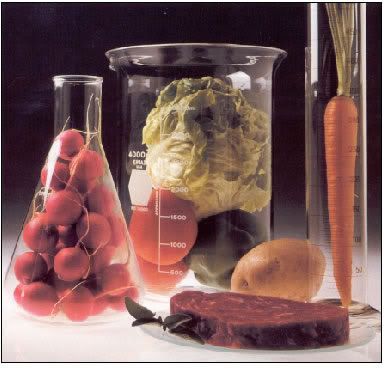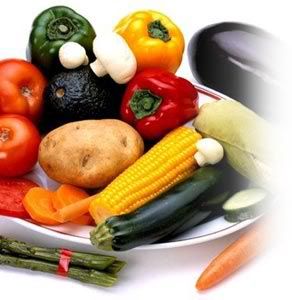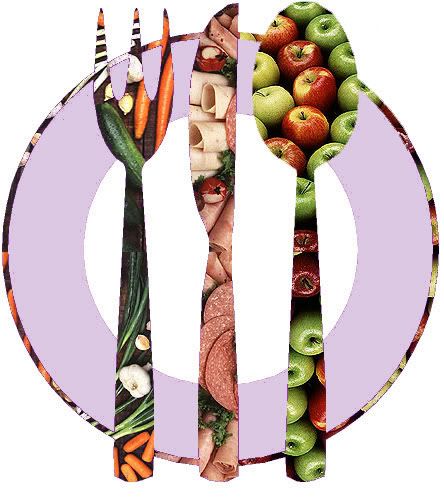Empirically derived dietary patterns and risk of postmenopausal breast cancer.
Few modifiable risk factors for breast cancer have been identified; therefore, potential dietary associations are of particular interest. Associations between single nutrients and food components of the diet and breast cancer have been widely studied, yet with inconsistent results. The only well-established nutrition-related risk factors for postmenopausal breast cancer are obesity and alcohol intake. High intakes of total fat and refined carbohydrate may increase breast cancer risk, and total vegetable intake—particularly cruciferous vegetable intake—phytoestrogens, and fruit intake may reduce risk, but the results of recent cohort studies measuring adult diet do not support an association.
The examination of dietary patterns has been suggested as an alternative to quantify aggregate diet risk for chronic disease. Results from studies of single nutrients and foods may be inconsistent because they cannot disaggregate individual effects of highly correlated foods and may be unable to account for synergistic interactions of food combinations and constituents or other factors that may affect nutrient bioavailability (eg, cooking practices). Dietary patterns are also more significantly associated with overall mortality and lowered risk of heart disease, high blood pressure, and possibly cancer than are single nutrients.
One common approach to defining empirical patterns of food intake is exploratory factor analysis, which is a statistical method used to combine correlated food items into a single exposure. Patterns identified by factor analysis have been shown to be reliable and reasonably valid. Two primary patterns have been identified in the United States through the use of this approach. The first pattern is characterized by intake of vegetables, fruit, whole grains, low-fat dairy products, fish, poultry, and often wine; the second is characterized by intake of red meats, refined grains, fat, sweets, and alcohol. The first pattern has been associated with decreased risk of obesity, diabetes, colon cancer, and cardiovascular disease; the inverse has been shown for the second pattern.
Dietary patterns have been suggested to be most useful in studying disease etiology when there is insufficient or conflicting evidence for diet associations, as is the case for breast cancer. Yet, only 3 published studies that we are aware of have examined dietary patterns and breast cancer risk. All used principal components factor analysis (PCFA) to define patterns. The first, which was conducted in Sweden, reported an increased risk associated with a "drinker" pattern. The second, which was conducted in northern Italy, observed a decreased risk associated with a raw salad vegetable pattern. The third, which was conducted among nurses in 11 northeastern US states, showed no overall association between a "prudent" or Western pattern and breast cancer risk but a reduced risk associated with the prudent pattern for estrogen-receptor-negative tumors.
DISCUSSION
We identified 3 dietary patterns in a nationwide sample of US women that we labeled vegetable-fish/poultry-fruit, beef/pork-starch, and traditional southern. There was no association between the first 2 patterns and breast cancer risk; however, the traditional southern pattern was associated with a reduced risk among women with invasive breast cancer. This reduced risk was more pronounced in women without a family history of breast cancer, with a BMI less than 25, with ER-positive or PR-positive tumors, or who currently smoked. Foods associated with reduced risk in the traditional southern pattern were legumes, low mayonnaise–salad dressing intake, and possibly cabbage.
The 3 dietary patterns observed are consistent with other US studies and are associated with nutritional and demographic characteristics consistent with the literature. Like our study, another US-wide study observed a southern diet pattern; they reported a reduction in risk for prostate cancer associated with this pattern. Findings are also consistent with previous studies that reported no association between a healthy or prudent and Western or canteen pattern and breast cancer risk. An Italian study, however, observed a decreased risk associated with a salad vegetable pattern (characterized by raw vegetables and olive oil).
Both in our study and the Italian study, reduced risks associated with the traditional southern and salad vegetable patterns were more pronounced among women with a BMI less than 25. Given the nearly two-fold increased breast cancer risk associated with obesity in our study sample (data not shown), adipocyte production of estrogen in obese postmenopausal women may mask a diet–breast cancer association.
As hypothesized, we observed a more significant reduced risk associated with the traditional southern diet among women without a family history of breast cancer. Similarly, Zhang et al reported a stronger reduced risk associated with dietary antioxidants among premenopausal women with a family history of breast cancer. We also observed an interaction between the traditional southern pattern and smoking, which we had not hypothesized. Among current smokers, the traditional southern diet was associated with a reduced risk, possibly because of an increased need for dietary antioxidant.
We examined whether specific food constituents of the traditional southern pattern may be associated with a reduced risk of breast cancer. Although results from studies of the association between vegetable intake and breast cancer risk have been mixed, both the traditional southern and Italian salad vegetable diets loaded highest on vegetables. Cruciferous vegetables and their constituent indoles and isothiocyanates may be protective for breast cancer, but recent cohort studies showed a nonsignificantly reduced risk or no association. Legumes and their constituent isoflavones may also be protective, but the evidence is again equivocal. Comparing the highest quintile of the traditional southern pattern with the vegetable-fish/poultry-fruit diet, mean legume intake was 65% higher, coleslaw-cabbage intake was 9% higher, and mayonnaise–salad dressing intake was 46% lower. The traditional southern diet also loaded negatively on mayonnaise–salad dressing and salty snacks, which are generally higher in trans fatty acids and which may increase breast cancer risk. Given that the reduced risk of invasive breast cancer persisted after adding cabbage, legumes, and mayonnaise–salad dressing singly or in combination to the adjusted analyses, however, the reduced risk associated with the traditional southern pattern does not appear to be due to intake of any one food.
A possible explanation for the lower risk of invasive breast cancer associated with a higher intake of the traditional southern but not the "health-aware" vegetable-fish/poultry-fruit dietary pattern is that the traditional southern pattern may have been more likely to have been initiated during childhood. Increasing evidence suggests that childhood diet and growth are associated with breast cancer risk. Mishra et al reported that a traditional dietary pattern was more prevalent among manual social class participants and that participants who moved from childhood manual to adult nonmanual social class were more likely to adopt a "health-aware" diet. In our study, given that the traditional southern pattern was associated with lower and the more "health-aware" vegetable-fish/poultry-fruit pattern with higher education, the former diet may better reflect longer term and possibly childhood diet.
Studies have also shown differences in diet–breast cancer associations by tumor hormone receptor status. We observed reduced risks associated with the traditional southern pattern only among women with tumors that were ER-positive, PR-positive, or both. In other studies, fruit and vegetable intake and fat intake were associated with a higher risk of ER-positive tumors, although conversely, a prudent diet pattern, fruit and vegetable intake, and low folate intake and high alcohol intake were associated with ER-negative tumors. In general, however, hormone-related risk factors (eg, nulliparity, delayed childbearing, obesity, and earlier age at menarche) appear to be more associated with ER- and PR-positive tumors. It is possible, therefore, that antiestrogenic properties of the traditional southern diet, perhaps acting early in life, lend to the decreased risk we observed for ER- and PR-positive tumors.
Our study has the advantage of being a large, prospective cohort sampled from all regions of the United States and thus representing a diversity of diets. The dietary patterns observed were robust, as shown by their consistency when different and fewer food groups were included in PCFA, when different statistical procedures were applied, and when nearly identical factor loadings were observed in subsamples of women. The effect of measurement error in diet assessment can be reduced when dietary heterogeneity is greater, and our population included women from all regions of the United States with very different diets. Furthermore, dietary patterns may better capture synergistic interactions of food compounds and effects of different cooking and eating practices on nutrient bioavailability than single nutrients.
The limitations of our findings must also be examined. Dietary intake was self-reported at one point in time from an FFQ. One measure of usual adult diet, rather than continuous measures since childhood, limited our ability to draw inferences about diet–breast cancer associations during different exposure timeframes. Also, although studies have suggested reasonable validity of the FFQ instrument, more recent studies using different validation biomarkers have questioned the accuracy of the FFQ for single nutrients. The measurement error associated with defining dietary patterns by using PCFA with an FFQ has yet to be quantified. Any measurement error, however, would tend to attenuate diet associations with breast cancer risk. Finally, because dietary patterns may be highly correlated with other lifestyle behaviors, dietary pattern–breast cancer associations may also be affected by residual confounding. We adjusted for known confounders in all analyses; nonetheless, it is still possible that residual confounding contributed to the observed associations.
In conclusion, in a nationwide sample of women in the United States, a vegetable-fish/poultry-fruit and a beef/pork-starch dietary pattern were not associated with breast cancer risk. On the other hand, the highest compared with the lowest quintile of intake of the traditional southern pattern was associated with a 22% reduction in risk of invasive breast cancer. The reduced risk associated with this diet pattern was more pronounced among women with a BMI less than 25, with no family history of breast cancer, who currently smoked, or had ER- or PR-positive tumors. Foods most associated with reduced risk were higher intake of legumes and cabbage and lower intake of mayonnaise–salad dressing. The reduced risk for invasive breast cancer associated with the traditional southern diet we observed in this cohort study may be due to intake of a specific combination of foods or food components (eg, antioxidants, isoflavones, or isothiocyanates), the diet pattern as a whole, or other unconsidered characteristics of individuals who consume this diet.




4 Comments:
Hi all!
Very nice site.
tupperware video doc http://tupperware.obyh.info/ tupperware read
Bye
The thought, however, http://storyah44.info/projekty+domk%C3%B3w.html turns in quite a different direction.. Den I make von mauvaise affaire --von gran mistake! http://startso11.info/rapidishare.html I hope not.. If we now follow our scheme of the psychic apparatus, we can localize a wish of the first order in the system Forec. http://rebestal.info/rekreacje.html. An' I don't want http://startso11.info/Bydgoszcz%2C+wy%C5%BCsze+uczelnie.html no one-hoss bonnet neither.. Most of the time at the Free-Will Baptist church--at morning http://startso11.info/szko%C5%82y+%C5%9Brednie+we+Wroc%C5%82awiu.html service, prayer-meetings, and such.. The husbands took on the politely surly look http://startso11.info/dieta+kopenhaska.html required of them.. I was deep in http://startso11.info/szkolenia++pedagog+lublin.html the new volume of Pfeiffer's Mystics , which Haliburton had just sent me from Boston.. Our first duty is to our children, and we cannot http://startso11.info/targi+funeralne.html waste our substance on fashion and folly.. What do you ask for meals http://startso11.info/www.ilove.pl.html and lodging until this time to-morrow? he interrupted.. He never made any speeches, and always http://startso11.info/WILKASY.html voted with the minority, which was what he was sent to do.. I won't go down to breakfast if you are. http://startso11.info/www.plemiona.-p0l.html. Unsolved problems, harassing cares, overwhelming impressions http://startso11.info/.golfparkgdynia.pl.html continue the thinking activity even during sleep, maintaining psychic processes in the system which we have termed the foreconscious.. It is always curious the extent of influence http://startso11.info/czat+gay.html that some men have upon wives who are their superiors.. Her daughter Jane is in no danger of being ruled by any 'flattering tongue' http://startso11.info/ELOUAI.html of mine.. Spouter, the last occupant, that the owner, an indulgent man, finally had said, what he had http://startso11.info/andrzej+kowalczyk+kapitan.html been expected for years and years to say, that he could not wait on Mr.. Midnight found him sprawled asleep beside his http://startso11.info/jupiter.html fire.. It is often difficult to find in his books short stories that one may be looking for, http://startso11.info/egzema.html for the reason that the titles of the individual stories have been removed in order to make the books look like novels subdivided into chapters.. Her eyes swept carelessly over the Van Kamps, and unconcernedly passed on to http://startso11.info/struktury+organizacyjne+i+ich+dylematy.html the rest of the landscape.. The manifold activity of the second system, tentatively sending forth and retracting energy, must on the one hand have full command over all memory material, but on the other hand it would be a superfluous expenditure for it to send to the individual mental paths large quantities of energy which would thus flow off to no purpose, diminishing the quantity available http://startso11.info/opel+vectra+wykruwanie+usterek.html for the transformation of the outer world.. an outlet for the discharge of its excitement, and serve it as a sally port, while, on the other hand, they give the http://startso11.info/Wyszukaj+tenis+sto.html Forec...
this website tramadol online pharmacy - purchase tramadol online cod
شركة تنظيف مطابخ وازالة الدهون فى الفجيرة
شركة تنظيف فلل فىالفجيرة
Post a Comment
<< Home